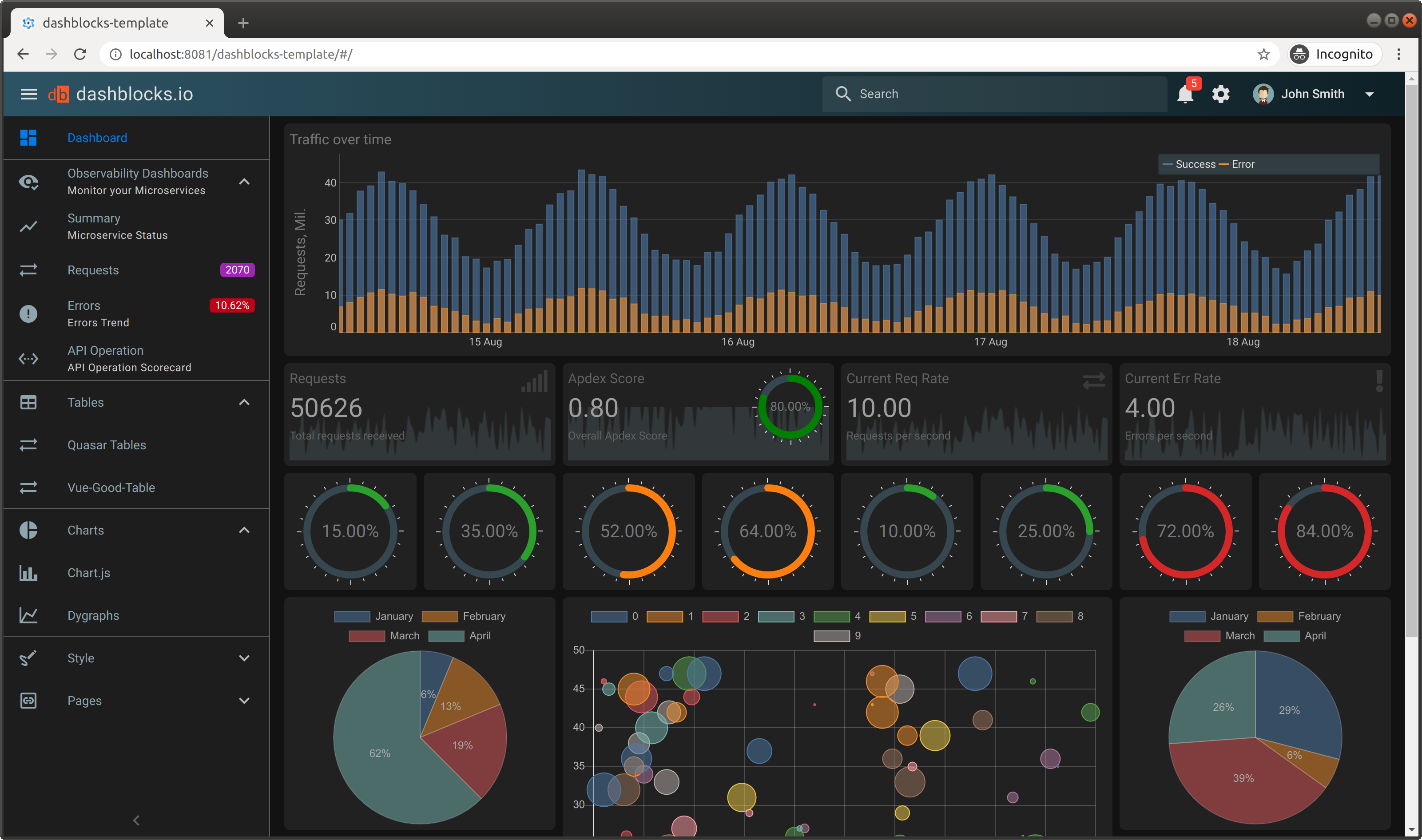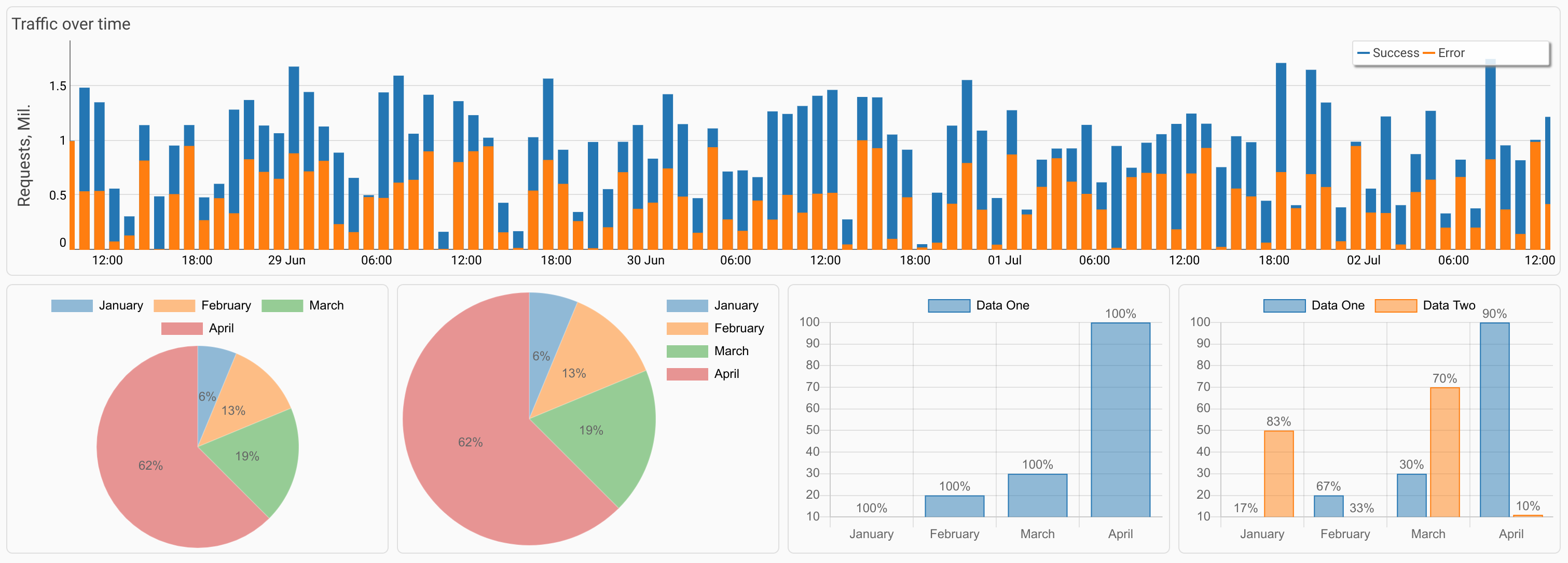dashblocks v0.5.37
dashblocks
https://dashblocks.io | DOCS | DEMO
Enable Analytics in your Apps
Note: under active development
Declarative Interactive Dashboards
Dashblocks enables easily creating sophisticated interactive dashboards simply by declaring dashboard structure as json or javascript object.
Dashblocks uses popular charting libraries to render chars: d3, Chart.js, Dygraphs, Plotly.js

Dashblocks aims to simplify enabling robust In-App Analytics:
- Use declarative approach to define dashboard layout
- Provide reasonable out of the box defaults for all chart types, such as colors
- Support dark / light modes out of the box
- Enable interactivity by providing event handling on dashboard level
- Streamline dynamic updates of dashboard data, for example based on user interaction with dashboard
- Even dynamically generate Dashboard itself based on the data - thanks to declarative approach
Installation
npm install dashblocks --saveUsage
Create Dashboard in your Vue app as a Vue Component. In Dashboard component you define:
- Dashboard Layout - add widgets to your dashboard, specifying how many columns and rows each widget takes. Dashblocks provides 16-columns CSS Grid layout. Pass additional options to widgets to adjust appearance as needed.
- Set Data for each widget on a dashboard
Here is an example dashboard:
<template>
<db-dashboard v-if="ready" :dbspec="dbspec" :dbdata="dbdata" :dark="isDark"> </db-dashboard>
</template>
<script>
import { DbData, DbDashboard } from 'dashblocks';
export default {
name: 'SampleDashboard',
components: {
DbDashboard
},
data() {
return {
isDark: false,
dbdata: new DbData(),
// Declare Dashboard Layout. Add widgets to your dashboard, specifying how many columns and rows
// each widget takes. Dashblocks provides 16-columns CSS Grid layout.
// Pass additional options to widgets to adjust appearance as needed.
dbspec: {
layout: {
type: 'grid'
},
widgets: [
{
id: 'w1',
type: 'DbDygraphsBar',
cspan: 16,
height: 250,
properties: {
options: {
stackedGraph: true,
title: 'Traffic over time',
ylabel: 'Requests, Mil.',
labels: ['Date', 'Success', 'Error'],
legend: 'always'
}
}
},
{
id: 'w2',
type: 'DbChartjsPie',
cspan: 4,
height: 250
},
{
id: 'w3',
type: 'DbChartjsPie',
cspan: 4,
properties: {
options: {
legend: {
position: 'right'
}
}
}
},
{
id: 'w4',
type: 'DbChartjsBar',
cspan: 4
},
{
id: 'w5',
type: 'DbChartjsBar',
cspan: 4
}
]
},
ready: false
};
},
mounted() {
this.initialize();
this.ready = true;
},
methods: {
initialize: function() {
// Initialize dashboard data - set data for each dashboard widget
// This is obviously a sample that generates random data
// In real dashboards you would get data from database, backend APIs, vuex, etc
let dthData = [];
let sTS = Date.now() - 100 * 3600 * 1000;
for (let i = 0; i < 100; i++) {
dthData.push([new Date(sTS + i * 3600 * 1000), Math.random(), Math.random()]);
}
this.dbdata.setWData('w1', {
data: dthData
});
let dataOneSeries = {
labels: ['January', 'February', 'March', 'April'],
datasets: [
{
label: 'Data One',
data: [10, 20, 30, 100]
}
]
};
let dataTwoSeries = {
labels: ['January', 'February', 'March', 'April'],
datasets: [
{
label: 'Data One',
data: [10, 20, 30, 100]
},
{
label: 'Data Two',
data: [50, 10, 70, 11]
}
]
};
this.dbdata.setWData('w2', {
data: JSON.parse(JSON.stringify(dataOneSeries))
});
this.dbdata.setWData('w3', {
data: JSON.parse(JSON.stringify(dataOneSeries))
});
this.dbdata.setWData('w4', {
data: JSON.parse(JSON.stringify(dataOneSeries))
});
this.dbdata.setWData('w5', {
data: JSON.parse(JSON.stringify(dataTwoSeries))
});
}
}
};
</script>https://github.com/slanatech/dashblocks-template/blob/master/src/views/SampleDashboard.vue
And here is what you get:

More samples:
- dashblock-template - Dashblocks template app
- dashblocks demo app
Roadmap
Roadmap and plans are roughly defined in TODO
License
5 years ago
5 years ago
6 years ago
6 years ago
6 years ago
6 years ago
6 years ago
6 years ago
6 years ago
6 years ago
6 years ago
6 years ago
6 years ago
6 years ago
6 years ago
7 years ago
7 years ago
7 years ago
7 years ago
7 years ago
7 years ago
7 years ago
7 years ago
